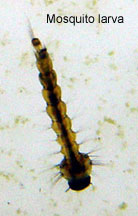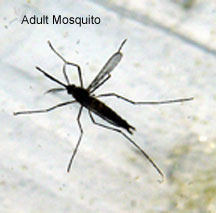 |
 |
|||||||||||||||
Salt marsh mosquitoes will lay eggs in water that remains stagnant for longer than 5 days. Upper tide pools that are formed in a spring high tide may exist for days. Unlike the woodland mosquitoes, salt-marsh mosquitoes (Aedes cantator and A. sollicitans) travel much longer distances, ten to twenty miles or more from the coast, in their search for food. Eggs are laid in depressions and hatch upon being submerged as a result of flooding due to heavy rainfall or high tides. Larvae filter feed with their brush-like mouths during development in the pool. As a rule, the frequency of high tides determines the frequency of generations. Each generation increases the population. In some seasons, there may be two high tides each month with a new generation of mosquitoes produced with each one. (From the Maine Mosquito Factsheet, UM Cooperative Extension Service and Pest Management Lab, 2004) |
||||||||||||||||
|
||||||||||||||||
|
||||||||||||||||



